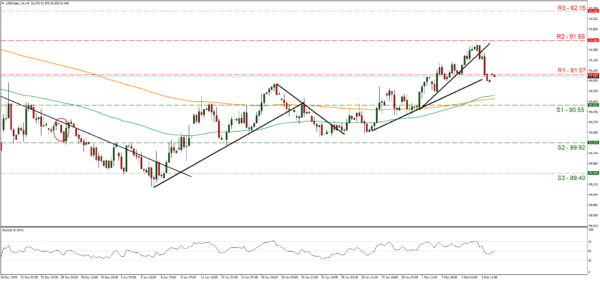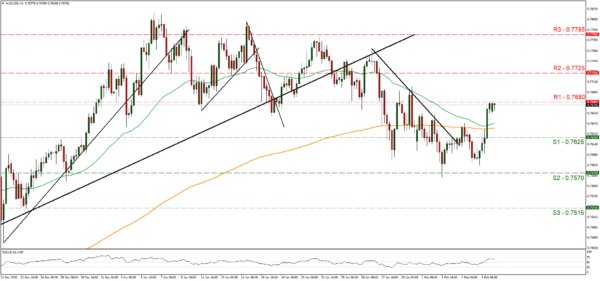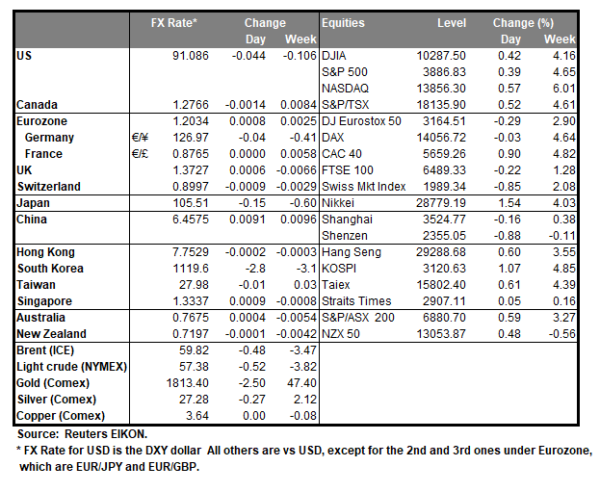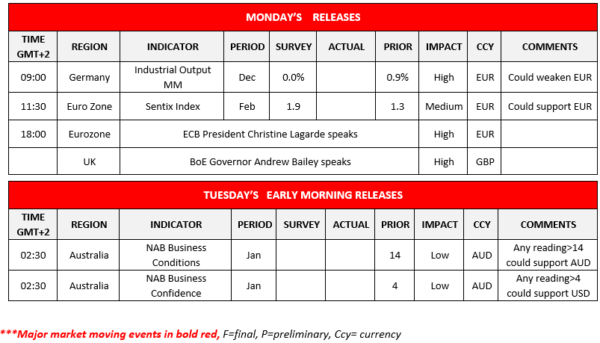The USD retreated against a number of its counterparts on Friday and during today’s Asian session as worries for the rebound of the US employment market tended to resurface after a relative euphoria for the comeback of the US economy. Despite the unemployment dropping and the NFP figure landing in the greens as expected, the markets may have been expecting something more. On the other hand, US stock markets tended to gain with the S&P500 reaching new record highs, as the soft employment data may have intensified hopes for a generous fiscal stimulus package in order to also boost the US employment market. Despite US Treasury Secretary Yellen not denying that the stimulus package may not have been designed explicitly for employment market, she also stated that the increased demand which could be generated, could create new jobs, while other economists worry for increased inflationary pressures. Should worries for the rebound of the US economy persist , we may see the USD weakening further and vice versa.
The USD index dropped on Friday breaking the 91.07 (R1) support line, now turned to resistance. Given that (R1) seems to be holding its ground in the Asian session, we maintain temporarily a bias for a sideways movement, yet market sentiment may alter that. Also the RSI indicator below our 4-hour chart is below the reading of 50, reminding us of the presence of the bears. Should the bears actually take charge we may see the index aiming for the 90.55 (S1) support line which troubled the index at the end of January. Should the bulls take over, we may see the index finally breaking the 91.07 (R1) line and aim for the 91.65 (R2) level.
Aussie gains on USD weakness
The Aussie gained against the USD on Friday as a positive market sentiment and the USD weakness may have enhanced the commodity currency. Also a relative optimism for the possible global economic recovery and a boost in global trade tended to support the riskier Australian Dollar. On the other hand though it should be noted that the worries with the slow pace of vaccination as well as the alarming news about the poor effectiveness of the existing vaccines against the South African variant of the virus (note AstraZeneca) tended to keep gains capped. Should market sentiment turn to be cautious, we may see the AUD relenting some of Friday’s gains, while tomorrow we get the NAB indicators for January.
AUD/USD rallied yesterday, breaking the 0.7625 (S1) resistance line, now turned to support and continued higher to test the 0.7680 (R1) resistance level. Given that the pair has stabilised just below the (R1) we tend to expect the pair initially to remain in a sideways motion albeit the RSI indicator below our 4-hour chart, implies that he bulls may have an advantage still. Should the pair find renewed extensive buying orders along its path, we may see AUD/USD, breaking the 0.7680 (R1) line and aim for the 0.7785 (R2) level. If a selling interest is displayed by the markets, AUD/USD could aim if not break the 0.7625 (S1) support level.
Other economic highlights today and early Tuesday:
Today during the European session, we note Germany’s industrial output for December and Eurozone’s Sentix index for February. As for speakers we note the ECB President Christine Lagarde as well as BoE Governor Bailey. During Tuesday’s Asian session, we get from Australia the NAB indicators for January.
As for the rest of the week
On Tuesday, we get Germany’s trade data for December. On Wednesday, we note Japan’s corporate goods prices for January, China’s PPI and CPI rates for January, Germany’s final HICP rates for January, Norway’s CPI rates for January, Riksbank’s interest rate decision, the US inflation measures for January, while ECB President Lagarde and Fed Chairman Powell speaks. On Thursday, we get the weekly US initial jobless claims figure. On Friday, we get UK’s manufacturing output growth rate for December, UK’s preliminary GDP rates for Q3 and December and from the US the preliminary University of Michigan consumer sentiment for February.
Support: 90.55 (S1), 89.92 (S2), 89.40 (S3)
Resistance: 91.07 (R1), 91.65 (R2), 92.15 (R3)
Support: 0.7625 (S1), 0.7570 (S2), 0.7515 (S3)
Resistance: 0.7680 (R1), 0.7725 (R2), 0.7785 (R3)

















